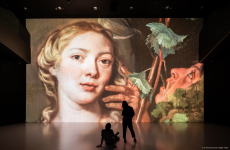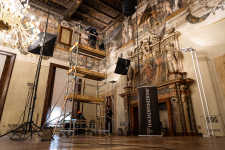The 21-year-old Raphael painted it in 1504, for this location and it remained one of his most famous works. It was removed to Milan in 1798 by Giuseppe Lechi, a General under Napoleon.
This is not the original altarpiece; that remains in the collection of the Pinacoteca di Brera in Milan. This copy is its perfect clone, a surprisingly accurate replica which is the result of sophisticated new digital acquisition technology and the newest 3D printers, which are capable of faithfully reproducing Raphael’s textured brush strokes, tracings, cracks and all the little blemishes that are part of the original panel.
The three-dimensional copy of The Marriage of the Virgin that has been placed in the chapel that housed the original, uses the ultra-high definition “Gigapixel+3D” digital image data that was captured in the Pinacoteca di Brera on November 2 this year, in which we celebrate 500 years since the death of Raphael. The work was done by the high-tech company Haltadefinizione, branch of the publishing company Franco Cosimo Panini Editore dedicated to the fine arts and cultural heritage.
Haltadefinizione’s proprietary ultra-high definition “Gigapixel+3D” image technology makes it possible to create high resolution digital copies of paintings, by uniting a vast number of individual photographic images of small portions of the same subject. For example, for the Marriage of the Virgin, there are 4,250 photograms which the software is made to display. It can produce extremely detailed images, made of billions of pixels and able to display the smallest and most imperceptible details of a painting. The digital acquisition of this masterpiece required fifteen days of data processing and it generated a huge single TIFF file of 1.13 Terabytes. But that’s not all. A process developed by Haltadefinizione together with its partner Memooria, allows for the collection of data from the object’s surface, to make a kind of digital cast of the painting’s surface details with a three-dimensional imprint, showing details down to 10 microns. With the data that is collected this way, it is possible to make a new kind of print, that faithfully reproduces the surface of a painting, in terms of its physical shape and its colors. This produces a true clone, visually identical to the original.
With the reinstallation of the ultra-high definition twin of Raphael’s The Marriage of the Virgin, anyone who visits the church of Saint Francis in Città del Castello, will be treated to the same views that a visitor in the 1500s would enjoy. The experience is completed by the restoration of the original gold-painted wooden frame that surrounded the original panel, which has been brought back to its original spendor for the occasion.
In addition to that, Franco Cosimo Panini Editore and Haltadefinizione will donate another clone of The Marriage of the Virgin to the Pinacoteca di Brera. This will be used as a teaching tool and also as an important record of the conservation status of the work, which will allow researchers to identify changes to its surface and coloration over time.
Apart from its value as a fine example of innovation in the fields of fine arts and cultural heritage, this copy, and the event celebrating its installation, stand, most of all, as a gesture offered to the local community, that Franco Cosimo Panini Editore and Haltadefinizione have chosen to make to the town of Città di Castello and to Umbria, to celebrate Christmas in this year of unusual hardship.
For this reason they have organized the inaugural event for the evening of December 23, to celebrate the placement of the work. The inaugural event is designed by the local director Giuseppe Sterparelli, to mark the event for his fellow citizens with some high-profile theatrical imagery, and also to compensate for the fact that it will not be possible to enter the church to see it. This event is a precursor to next year’s national exhibition “The Gaze of Young Raphael” (“Raffaello giovane e il suo sguardo”) due to open in Città di Castello in 2021 (postponed due to the Coronavirus emergency), financed by the National Committee for the artist’s 500th anniversary.



